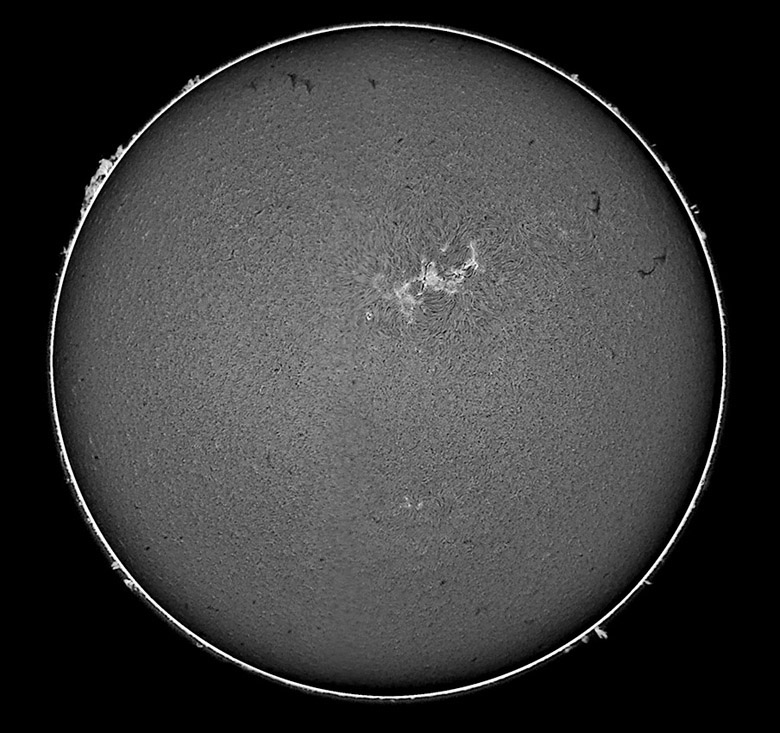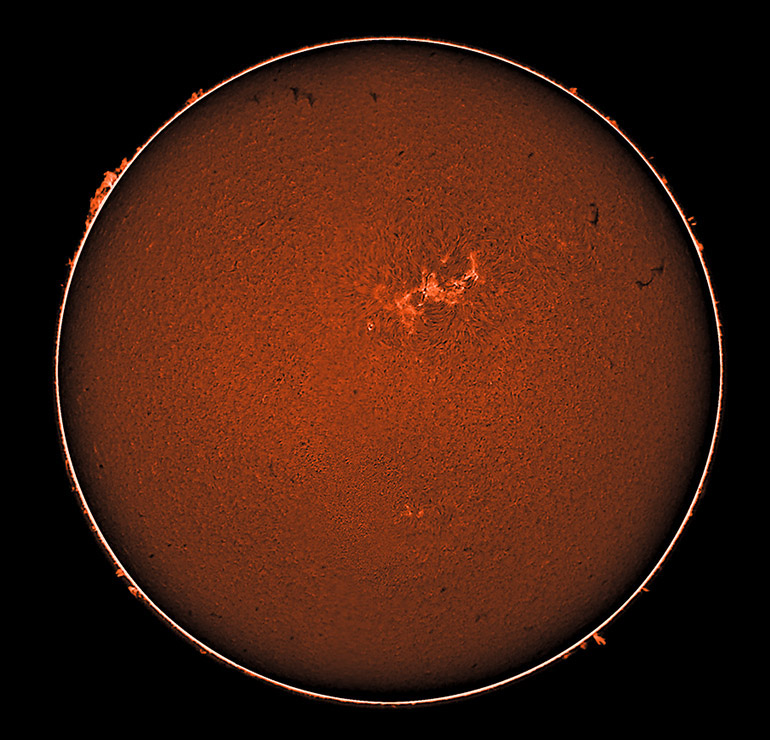|
Staring at the Sun, 12 :: home :: |
|
7/14/2010. Ho hum. Another day, another solar flare. This morning's was a C1-class event which, as Spaceweather.com notes, is no big deal in the grand scheme of things. Still, as they also note, it released energy equivalent to millions of nuclear bombs. This photo was made about 90 minutes after the reported time of the C1 flare. It consists of six 1/4-second frames of each hemisphere of the sun, plus two 2-second exposures (one of each hemisphere) to capture prominences:
Lunt LS60Ha
with DS50 on A-P Mach1.
I came close to nailing the focus this time and it's reflected in the much less aggressive sharpening and contrast boosts required. That and the fewer number of subframes made controlling the dynamic range of the solar disk much easier. I need to measure the amount of drift I'm getting owing to poor polar alignment. I don't think that in these brief exposures that this is going to degrade sharpness, but it needs to be worked out. I am impressed with how much drift occurs between the first and last frame of a fairly brief sequence, so I suppose it's possible that fine detail could be smeared in 1/4 to 2 second exposures. (Here's a footnote looking into the effect.) And here's the black and white image above colorized. There's also a link to a wallpaper-sized version:
Later that same day: About 5:00 PM, I checked the Sacramento Peak near realtime H-a image and saw that something was up. Half the active region was much brighter than the other half and much brighter than before. A glance at the X-ray flux report showed a class C3 flare in progress. Clouds were getting troublesome here. Still, I grabbed an eyepiece, the 50D, a pair of focussing glasses (aka reading glasses) and the Seibert hood and headed for the telescope. I used the first thin spot in the clouds to verify that the flare was visible. It was a pronounced brightening of parts of already brilliant AR 11087. When examined closely, narrow, brilliant threads stretched here and there within the convoluted region. These bright knots and threads put me in mind of solar lightning. Then I powered up the mount, clamped the clutches, readied the camera and waited for a chance to focus and after that for a chance to shoot pictures. I used the same settings as earlier today in case there is a good chance to compare details. When I came back inside with a couple of dozen images in hand, the X-ray monitor showed the event still in progress. I've processed these images a little differently in an effort to better show the "flash tubes" within the active region.
Five, 1/4 second
exposures. Barlow on EP projection tube.... the usual.
This photo above was made within a very few minutes of the peak of the event shown on the far right side of the graph below. I'm guessing that this flare was aimed just about perfectly to produce an auroral display, but I wonder if it was powerful enough to drive the lights south as far as North Carolina.
7/17/2010: A quick look this afternoon showed AR11087 sprawling and laced with filaments, headed for the limb of the Sun in a few days. Meanwhile, a smaller active region is rotating into view. Careful looks at both and at prominences all around the disk prove that I've made real progress: without a doubt, the photos now show more than I can see.
7/19/2010: Something old retreated toward one limb; something new came around the other. The new locus of interest is newly-christened AR 11089, about 170 degrees of solar longitude (or 12 days of rotation) behind 11086. This image showing the new kid on the block was shot without double-stacking to make sure I can get appreciable disk detail using only the internal etalon. That's the way I will have to use the 90mm objective after I get it working next week (or the week after). Here you go:
Ten 0.01s exposures,
barlow on EP adapter,
Sure it would have been better with
stacked filters, but it's promising. It could be improved through
better focus and more careful processing. It was made between clouds
and late enough in the afternoon that the air mass was significant.
All in all this seems encouraging. |
:: top ::
© 2010, David Cortner




